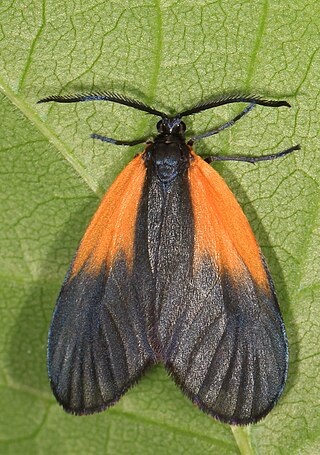
The Arctiinae are a large and diverse subfamily of moths with around 11,000 species found all over the world, including 6,000 neotropical species. This subfamily includes the groups commonly known as tiger moths, which usually have bright colours, footmen, which are usually much drabber, lichen moths, and wasp moths. Many species have "hairy" caterpillars that are popularly known as woolly bears or woolly worms. The scientific name Arctiinae refers to this hairiness. Some species within the Arctiinae have the word "tussock"' in their common names because they have been misidentified as members of the Lymantriinae subfamily based on the characteristics of the larvae.

The Sesiidae or clearwing moths are a diurnal moth family in the order Lepidoptera known for their Batesian mimicry in both appearance and behaviour of various Hymenoptera.

Lycomorpha is a genus of moths in the family Erebidae. The genus was erected by Thaddeus William Harris in 1839.

Chalcopasta is a genus of owlet moths in the family Noctuidae. There are about nine described species in Chalcopasta.

Zale is a genus of moths in the family Erebidae erected by Jacob Hübner in 1818.

Drasteria is a genus of moths in the family Erebidae.

Hemeroplanis is a genus of moths of the family Erebidae. The genus was erected by Jacob Hübner in 1818.
Barbara fulgens, the lustrous spruce cone moth, is a moth of the family Tortricidae. It is found in north-eastern China and eastern Russia.
Carmenta texana, the Texana clearwing moth, is a moth of the family Sesiidae. It was described by Henry Edwards in 1881 and is known from the US states of Texas and Florida.

Lycomorpha pholus, the black-and-yellow lichen moth, is a moth in the family Erebidae. It is found in North America from Nova Scotia to North Carolina, west to South Dakota and Texas. The habitat consists of short-grass prairie.

Arctia opulenta is a moth of the family Erebidae. It was described by Henry Edwards in 1881. It is found from Alaska through northern British Columbia to Labrador. The habitat consists of arctic tundra and alpine and subalpine tundra.

Lycomorpha grotei, or Grote's lycomorpha moth, is a moth of the family Erebidae. It was described by Alpheus Spring Packard in 1864. It is found in North America, including Arizona, California, Colorado, Montana, Nevada, South Dakota, Texas, Utah and Wyoming.
Lycomorpha regulus is a moth of the family Erebidae. It was described by Fordyce Grinnell Jr. in 1903. It is found in North America, including Arizona, California, Colorado and Utah.
Lycomorpha splendens is a moth of the family Erebidae. It was described by William Barnes and James Halliday McDunnough in 1912. It is found in North America, including Arizona, California, Nevada, New Mexico, Texas and Utah.
Lycomorpha desertus is a moth of the family Erebidae. It was described by Henry Edwards in 1881. It is found in the US state of Arizona.

Pyromorpha dimidiata, the orange-patched smoky moth, is a species of leaf skeletonizer moth of the family Zygaenidae found in eastern North America.

The Cisthenina are a subtribe of lichen moths in the family Erebidae, currently containing 428 described species.
Oreta fulgens is a moth in the family Drepanidae. It was described by William Warren in 1899. It is found on Borneo, Peninsular Malaysia, the Philippines, Sulawesi, Buru and Seram.

Chalcopasta fulgens is a moth in the family Noctuidae. It was described by William Barnes and James Halliday McDunnough in 1912 and is found in North America.











